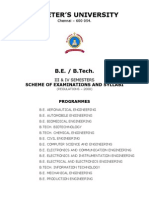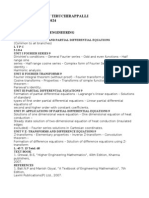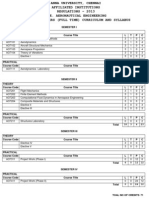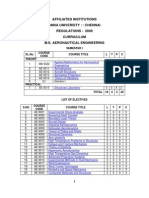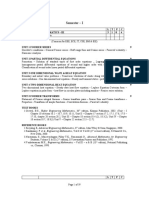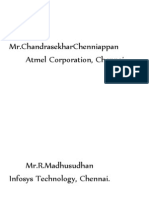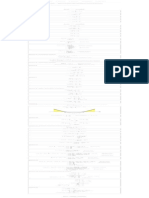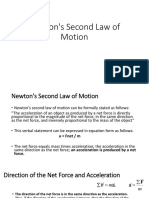Affiliated Institutions Anna University of Technology Chennai:: Chennai 600 113 Curriculum 2010
Affiliated Institutions Anna University of Technology Chennai:: Chennai 600 113 Curriculum 2010
Uploaded by
Gowri ShankarCopyright:
Available Formats
Affiliated Institutions Anna University of Technology Chennai:: Chennai 600 113 Curriculum 2010
Affiliated Institutions Anna University of Technology Chennai:: Chennai 600 113 Curriculum 2010
Uploaded by
Gowri ShankarOriginal Title
Copyright
Available Formats
Share this document
Did you find this document useful?
Is this content inappropriate?
Copyright:
Available Formats
Affiliated Institutions Anna University of Technology Chennai:: Chennai 600 113 Curriculum 2010
Affiliated Institutions Anna University of Technology Chennai:: Chennai 600 113 Curriculum 2010
Uploaded by
Gowri ShankarCopyright:
Available Formats
AFFILIATED INSTITUTIONS ANNA UNIVERSITY OF TECHNOLOGY CHENNAI :: CHENNAI 600 113 CURRICULUM 2010
B.E. AERONAUTICAL ENGINEERING CURRICULA AND SYLLABI FOR III SEMESTER SEMESTER III (Applicable to the students admitted from the Academic year 2010 2011 onwards) CODE NO. COURSE TITLE L T P C THEORY 181301 Transforms And Partial Differential Equations 3 1 0 4 111301 Mechanics of Machines 3 1 0 4 111302 Aero Engineering Thermodynamics 3 1 0 4 113303 Fluid Mechanics and Machinery 3 1 0 4 111303 Solid Mechanics 3 1 0 4 111304 Elements of Aeronautics 3 0 0 3 PRACTICAL 111351 Strength of Materials Lab 0 0 3 2 111352 Fluid Mechanics and Machinery Lab 0 0 3 2 111353 Thermodynamics Lab 0 0 3 2
SEMESTER III 181301 TRANSFORMS AND PARTIAL DIFFERENTIAL EQUATIONS (Common to all branches) OBJECTIVES The course objective is to develop the skills of the students in the areas of Transforms and Partial Differtial Equations. This will be necessary for their effective studies in a large number of engineering subjects like heat conduction, communication systems, electro-optics and electromagnetic theory. The course will also serve as a prerequisite for post graduate and specialized studies and research. 1. FOURIER SERIES 9+3 3 1 0 4
Dirichlets conditions General Fourier series Odd and even functions Half range sine series Half range cosine series Complex form of Fourier Series Parsevals identify Harmonic Analysis. 2. FOURIER TRANSFORMS 9+3
Fourier integral theorem (without proof) Fourier transform pair Sine and Cosine transforms Properties Transforms of simple functions Convolution theorem Parsevals identity. 3. PARTIAL DIFFERENTIAL EQUATIONS 9 +3
Formation of partial differential equations Lagranges linear equation Solutions of standard types of first order partial differential equations - Linear partial differential equations of second and higher order with constant coefficients. 4. APPLICATIONS OF PARTIAL DIFFERENTIAL EQUATIONS 9+3
Solutions of one dimensional wave equation One dimensional equation of heat conduction Steady state solution of two-dimensional equation of heat conduction (Insulated edges excluded) Fourier series solutions in cartesian coordinates. 5. Z -TRANSFORMS AND DIFFERENCE EQUATIONS 9+3
Z-transforms - Elementary properties Inverse Z-transform Convolution theorem -Formation of difference equations Solution of difference equations using Z-transform. Lectures : 45 Tutorials : 15 Total : 60
TEXT BOOKS
1. Grewal, B.S, Higher Engineering Mathematics 40th Edition, Khanna publishers,
Delhi, (2007) REFERENCES 1. Bali.N.P and Manish Goyal A Textbook of Engineering Mathematics, Seventh Edition, Laxmi Publications(P) Ltd. (2007) 2. Ramana.B.V. Higher Engineering Mathematics Tata Mc-GrawHill Publishing Company limited, New Delhi (2007). 3. Glyn James, Advanced Modern Engineering Mathematics, Third editionPearson Education (2007). 4. Erwin Kreyszig Advanced Engineering Mathematics, Eighth edition-Wiley India (2007).
111301 OBJECTIVE
MECHANICS OF MACHINES (Common to Automobile and Aeronautical)
3 1 0 4
To expose the students the different mechanisms, their method of working, Forces involved and consequent vibration during working 1. MECHANISMS 9+3 Machine Structure Kinematic link, pair and chain Grueblers criteria Constrained motion Degrees of freedom - Slider crank and crank rocker mechanisms Inversions Applications Kinematic analysis of simple mechanisms Determination of velocity and acceleration. 2. FRICTION 9+3 Friction in screw and nut Pivot and collar Thrust bearing Plate and disc clutches Belt (flat and V) and rope drives. Ratio of tensions Effect of centrifugal and initial tension Condition for maximum power transmission Open and crossed belt drive. 3. GEARING AND CAMS 9+3
Gear profile and geometry Nomenclature of spur and helical gears Gear trains: Simple, compound gear trains and epicylic gear trains - Determination of speed and torque - Cams Types of cams Design of profiles Knife edged, flat faced and roller ended followers with and without offsets for various types of follower motions 4. BALANCING 9+3
Static and dynamic balancing Single and several masses in different planes Balancing of reciprocating masses- primary balancing and concepts of secondary balancing Single and multi cylinder engines (Inline) Balancing of radial V engine direct and reverse crank method 5. VIBRATION 9+3 Free, forced and damped vibrations of single degree of freedom systems Force transmitted to supports Vibration isolation Vibration absorption Torsional vibration of shaft Single and multi rotor systems Geared shafts Critical speed of shaft. TOTAL : 60 TEXT BOOKS Rattan.S.S, Theory of Machines, Tata McGrawHill Publishing Co, New Delhi,2004. Ballaney.P.L, Theory of Machines, Khanna Publishers, New Delhi, 2002. REFERENCES 1. 2. 3. 4. Rao, J.S and Dukkipati, R.V, Mechanism and Machine Theory, Second Edition, Wiley Eastern Ltd., 1992. Malhotra, D.R and Gupta, H.C., The Theory of Machines, Satya Prakasam, Tech. India Publications, 1989. Gosh, A. and Mallick, A.K., Theory of Machines and Mechanisms, Affiliated East West Press, 1989. Shigley, J.E. and Uicker, J.J., Theory of Machines and Mechanisms, McGrawHill, 1980.
1.
2.
5.
Burton Paul, Kinematics and Dynamic of Planer Machinery, Prentice Hall, 1979.
111302 OBJECTIVE
AERO ENGINEERING THERMODYNAMICS
3 1 0 4
To give a brief background of application of various laws of thermodynamics and its application in heat transfer, refrigeration and air-conditioning, jet propulsion system. 1. BASIC THERMODYNAMICS 15+3
Systems, Zeroth Law, First Law - Heat and work transfer in flow, Second law, Clausius statement - concept of entropy entropy change in non-flow processes. 2. AIR CYCLES 5+3
Otto, Diesel, Dual combustion and Brayton combustion cycles Air standard efficiency Mean effective pressure Actual and theoretical PV diagrams of two stroke and four stroke IC Engines. 3. THERMODYNAMICS OF ONE DIMENSIONAL FLUID FLOW 12+3
Application of continuity, momentum and energy equations- Rankine cycle - Isentropic flow of ideal gases through nozzles - Simple jet propulsion system - Thrust rocket motor Specific impulse. 4. REFRIGERATION AND AIR CONDITIONING 6+3
Principles of refrigeration, Air conditioning - Heat pumps - Vapour compression - Vapour absorption types - Coefficient of performance, Properties of refrigerants. 5. AIR COMPRESSORS 7+3
Classification and working principle of compressors (Descriptive Treatment). Isothermal and Isentropic efficiency of air compressors. TOTAL : 60 TEXT BOOKS 1. 2. 3. Rathakrishnan, E, Fundamentals of Engineering Thermodynamics, Prentice Hall, India, 2000 Nag. P.K., Engineering Thermodynamics, Tata McGraw-Hills Co., Ltd., Seventh Edn., 1993 Yunus A.Cengal. Thermodynamics an Engineering Approach, Tata McGraw-Hill Co. Ltd., 3rd Edition, 2002.
REFERENCES 1. 2. 3. 4. 5. Mayhew, A. and Rogers, B., Engineering Thermodynamics, Longman Green & Co. Ltd., London, E.L.B.S. Edition, 1990. Van Wylen, G.J. and Sonntag, R.E., Fundamentals of Classical Thermodynamics (S.I.Version), Second Edition, 1986. Bacon, D.H., Engineering Thermodynamics, Butterworth & Co., London, 1989. Saad, M.A., Thermodynamics for Engineers, Prentice-Hall of India Pvt. Ltd., 1989. Reynolds, Thermodynamics, Int. Student Edn., McGraw-Hill Book Co., Ltd., 1990
113303
FLUID MECHANICS AND MACHINERY
3104
(Common to Aeronautical, Mechanical, Automobile & Production)
OBJECTIVES: The student is introduced to the mechanics of fluids through a thorough understanding of the properties of the fluids. The dynamics of fluids is introduced through the control volume approach which gives an integrated under standing of the transport of mass, momentum and energy. The applications of the conservation laws to flow though pipes and hydraulics machines are studied I. INTRODUCTION 12 Units & Dimensions. Properties of fluids Specific gravity, specific weight, viscosity, compressibility, vapour pressure and gas laws capillarity and surface tension. Flow characteristics: concepts of system and control volume. Application of control volume to continuity equiation, energy equation, momentum equation and moment of momentum equation. II. FLOW THROUG CIRCULAR CONDUITS 12 Laminar flow though circular conduits and circular annuli. Boundary layer concepts. Boundary layer thickness. Hydraulic and energy gradient. Darcy Weisbach equaition. Friction factor and Moody diagram. Commercial pipes. Minor losses. Flow though pipes in series and in parallel. III. DIMENSIONAL ANALYSIS 9 Dimension and units: Buckinghams theorem. Discussion on dimensionless parameters. Models and similitude. Applications of dimensionless parameters. IV. ROTO DYNAMIC MACHINES 16 Homologus units. Specific speed. Elementary cascade theory. Theory of turbo machines. Eulers equation. Hydraulic efficiency. Velocity components at the entry and exit of the rotor. Velocity triangle for single stage radial flow and axial flow machines. Centrifugal pumps, turbines, performance curves for pumps and turbines. V. POSITIVE DISPLACEMENT MACHINES 11 Recriprocating pumps, Indicator diagrams, Work saved by air vessels. Rotory pumps. Classification. Working and performance curves. TOTAL 60 TEXT BOOKS: 1. Streeter. V. L., and Wylie, E.B., Fluid Mechanics, McGraw Hill, 1983. 2. Rathakrishnan. E, Fluid Mechanics, Prentice Hall of India (II Ed.), 2007. REFERENCES: 1. Ramamritham. S, Fluid Mechanics, Hydraulics and Fluid Machines, Dhanpat Rai & Sons, Delhi, 1988. 2. Kumar. K.L., Engineering Fluid Mechanics (VII Ed.) Eurasia Publishing House (P) Ltd., New Delhi, 1995. 3. Bansal, R.K., Fluid Mechanics and Hydraulics Machines, Laxmi Publications (P) Ltd., New Delhi.
111303 OBJECTIVE
SOLID MECHANICS
3 1 0 4
To give brief descriptions on the behaviour of materials due to axial, bending and torsional and combined loads. 1. BASICS AND AXIAL LOADING 10+3
Stress and Strain Hookes Law Elastic constants and their relationship Statically determinate cases - statically indeterminate cases composite bar. Thermal Stresses stresses due to freely falling weight. 2. STRESSES IN BEAMS 10+3
Shear force and bending moment diagrams for simply supported and cantilever beamsBending stresses in straight beams-Shear stresses in bending of beams with rectangular, I & T etc cross sections-beams of uniform strength 3. DEFLECTION OF BEAMS 10+3 Double integration method McCauleys method - Area moment method Conjugate beam method-Principle of super position-Castiglianos theorem and its apllication 4. TORSION 5+3 Torsion of circular shafts - shear stresses and twist in solid and hollow circular shafts closely coiled helical springs. 5. BI AXIAL STRESSES 10+3
Stresses in thin circular cylinder and spherical shell under internal pressure volumetric Strain. Combined loading Principal Stresses and maximum Shear Stresses - Analytical and Graphical methods. TOTAL : 60 TEXT BOOKS 1. Nash William Strength of Materials, TMH, 1998 2. Timoshenko.S. and Young D.H. Elements of strength materials Vol. I and Vol. II., T. Van Nostrand Co-Inc Princeton-N.J. 1990. REFERENCES 1. Dym C.L. and Shames I.H. Solid Mechanics, 1990.
111304 OBJECTIVE
ELEMENTS OF AERONAUTICS
3 0 0 3
To introduce the basic concepts of aerospace engineering and the current developments in the field. 1. AIRCRAFT CONFIGURATIONS 6
Brief History-Components of an airplane and their functions. Different types of flight vehicles, classifications. Basic instruments for flying, 2. INTRODUCTION TO PRINCIPLES OF FLIGHT 8
Physical properties and structure of the atmosphere, Temperature, pressure and altitude relationships, Evolution of lift, drag and moment. Different types of drag. 3. INTRODUCTION TO AERODYNAMICS 9 Aerodynanic forces on aircraft classification of NACA aerofoils, aspect ratio, wing loading, Mach number,centre of pressure and aerodynamic centre-aerofoil characteristics-lift, drag curves. 4. INTRODUCTION TO AIRPLANE STRUCTURES AND MATERIALS 12
General types of construction, Monocoque, semi-monocoque. Typical wing and fuselage structure. Metallic and non-metallic materials, Use of aluminium alloy, titanium, stainless steel and composite materials. 5. POWER PLANTS USED IN AIRPLANES 10
Basic ideas about piston, turboprop and jet engines, Use of propeller and jets for thrust production., Principles of operation of rocket, types of rockets TOTAL : 45 TEXT BOOKS 1. Anderson, J.D., Introduction to Flight, McGraw-Hill, 1995.
REFERENCE 1. Kermode, A.C., Flight without Formulae, McGraw-Hill, 1997.
111351 OBJECTIVE
STRENGTH OF MATERIALS LABORATORY
0 0 3 2
To develop the knowledge in testing the materials for hardness, fatigue, impact, tension and torsion. LIST OF EXPERIMENTS Brinell Hardness test Rockwell Hardness test Tension test Torsion test Izod Impact test Charpy Impact test Reverse plate bending Fatigue test Rotating Beam Fatigue test Testing of springs Block Compression Test TOTAL : 45 PERIODS LIST OF EQUIPMENTS (for a batch of 30 students) Sl.No 1. 2. 3. 4. 5. Details of Equipments Hardness Testing Machine Universal Testing Machine Impact Testing Machine Fatigue tester- Rotating Beam Fatigue tester Reverse plate bending Qty Required 1 1 1 1 1 For Experiments 1, 2 1, 2, 3, 9, 10 5, 6 8 7
10
111352 OBJECTIVE
FLUID MECHANICS AND MACHINERY LABORATORY
0 0 3 2
To study the flow measurement and the performance of fluid machinery LIST OF EXPERIMENTS 1. 2. 3. 4. 5. 6. 7. 8. 9. 10. Calibration of venturimeter Pressure measurement with pitot static tube Determination of pipe flow losses. Verification of Bernoullis theorem Flow visualization by Heleshaw apparatus Performance test on centrifugal pumps Performance test on reciprocating pumps Performance test on piston wheel turbine Performance test on Francis turbine Determination of Viscosity of a Fluid TOTAL : 45 PERIODS LIST OF EQUIPMENTS (for a batch of 30 students) Sl.No 1. 2. 3. 4. 5. 6. 7. 8. 9. 10. Details of Equipments Venturimeter setup Pipe friction set up Pitot tube set up Jet pump Submersible pump Centrifugal pump Reciprocating pump Pelton wheel turbine and Francis turbine Viscosity Meter Hele-shaw apparatus Qty Req. 1 1 1 1 1 1 1 1 1 1 Experiment No. 1,3 3 2,4 6 6 6 7 8,9 10 5
11
111353 OBJECTIVE
THERMODYNAMICS LABORATORY
0 0 3 2
To enhance the basic knowledge in applied thermodynamics LIST OF EXPERIMENTS Performance test on a 4-stroke engine Valve timing of a 4 stroke engine and port timing of a 2 stroke engine Determination of effectiveness of a parallel flow heat exchanger Determination of effectiveness of a counter flow heat exchanger Determination of heating value of a fuel COP test on a vapour compression refrigeration test rig COP test on a vapour compression air-conditioning test rig Determination of specific heat of solid Determination of Thermal Conductivity of solid. Determination of Thermal Resistance of a Composite wall. TOTAL : 45 PERIODS LIST OF EQUIPMENTS (for a batch of 30 students) Sl.No 1. 2. 3. 4. 5. 6. 7. 8. Details of Equipments 4 stroke twin cylinder diesel engine Cut section model of 4 stroke diesel engine and cut section model of 2 stroke petrol engine Parallel and counter flow heat exchanger test rig Bomb Calorimeter Vapour compression refrigeration test rig Vapour compression air-conditioning test rig Conductive Heat Transfer set up Composite wall Qty Req. 1 1 1 1 1 1 1 1 Experiment No. 1 2 3,4 5 6 7 9 10
12
You might also like
- Schaum's Outline of Advanced Mathematics for Engineers and ScientistsFrom EverandSchaum's Outline of Advanced Mathematics for Engineers and ScientistsNo ratings yet
- XEMP Prediction Explanations With DataRobot White PaperNo ratings yetXEMP Prediction Explanations With DataRobot White Paper20 pages
- Anna University Tiruchirappalli Tiruchirappalli - 620 024No ratings yetAnna University Tiruchirappalli Tiruchirappalli - 620 02459 pages
- M.E. Aeronautical Engineering 2013 (Full Time) Anna University, Chennai Curriculum and SyllabusNo ratings yetM.E. Aeronautical Engineering 2013 (Full Time) Anna University, Chennai Curriculum and Syllabus27 pages
- B.E. (Full Time) Electrical and Electronics Engineering: Anna University Chennai-25. Syllabus ForNo ratings yetB.E. (Full Time) Electrical and Electronics Engineering: Anna University Chennai-25. Syllabus For47 pages
- 2639third Semester Bput 15-16 New RevisedNo ratings yet2639third Semester Bput 15-16 New Revised205 pages
- University Departments: Anna University Chennai:: Chennai 600 025 Regulations - 2008 Curriculum From Semesters ForNo ratings yetUniversity Departments: Anna University Chennai:: Chennai 600 025 Regulations - 2008 Curriculum From Semesters For22 pages
- Semester - I: LT P C PMA211 Mathematics - Iii 3 1 0 4No ratings yetSemester - I: LT P C PMA211 Mathematics - Iii 3 1 0 459 pages
- Anna Univ 3rd Sem, 5th Sem, 7th Sem Syllabus For AutoMobile Engineering - WWW - Annaunivedu.infoNo ratings yetAnna Univ 3rd Sem, 5th Sem, 7th Sem Syllabus For AutoMobile Engineering - WWW - Annaunivedu.info59 pages
- 11AU301 Engineering Mathematics III 3 1 0 4 100No ratings yet11AU301 Engineering Mathematics III 3 1 0 4 1001 page
- ME6352 Manufacturing Technology LTPC 3 0 0 3 ObjectivesNo ratings yetME6352 Manufacturing Technology LTPC 3 0 0 3 Objectives14 pages
- Anna Univ 3rd Sem, 5th Sem, 7th Sem Syllabus For Agriculture Irrigation Engg WWW - Annaunivedu.infoNo ratings yetAnna Univ 3rd Sem, 5th Sem, 7th Sem Syllabus For Agriculture Irrigation Engg WWW - Annaunivedu.info72 pages
- KANNUR UNIVERSITY BTech.S8 ME. SyllabusNo ratings yetKANNUR UNIVERSITY BTech.S8 ME. Syllabus13 pages
- M.E. Internal Combustion Engineering SyllabusNo ratings yetM.E. Internal Combustion Engineering Syllabus35 pages
- Sub Code: 15IM/IP 32 IA Marks: 25 Hrs/week: 04 Exam Hours: 03 Total Lecture HRS: 50 Exam Marks: 100No ratings yetSub Code: 15IM/IP 32 IA Marks: 25 Hrs/week: 04 Exam Hours: 03 Total Lecture HRS: 50 Exam Marks: 10014 pages
- The Steam Engine and Turbine - A Text Book for Engineering CollegesFrom EverandThe Steam Engine and Turbine - A Text Book for Engineering CollegesNo ratings yet
- Theory of Lift: Introductory Computational Aerodynamics in MATLAB/OctaveFrom EverandTheory of Lift: Introductory Computational Aerodynamics in MATLAB/Octave5/5 (1)
- Electrical Machines: Lecture Notes for Electrical Machines CourseFrom EverandElectrical Machines: Lecture Notes for Electrical Machines CourseNo ratings yet
- Group Theory in Quantum Mechanics: An Introduction to Its Present UsageFrom EverandGroup Theory in Quantum Mechanics: An Introduction to Its Present UsageNo ratings yet
- Short-Memory Linear Processes and Econometric ApplicationsFrom EverandShort-Memory Linear Processes and Econometric ApplicationsNo ratings yet
- Multiphase Catalytic Reactors: Theory, Design, Manufacturing, and ApplicationsFrom EverandMultiphase Catalytic Reactors: Theory, Design, Manufacturing, and ApplicationsNo ratings yet
- MR - Chandrasekharchenniappan Atmel Corporation, ChennaiNo ratings yetMR - Chandrasekharchenniappan Atmel Corporation, Chennai5 pages
- Dividing Decimals by 10, 100 and 1,000: © White Rose Maths 2020No ratings yetDividing Decimals by 10, 100 and 1,000: © White Rose Maths 20202 pages
- 27 Principal Ideal Domains and Euclidean Rings: 1 1 K K I INo ratings yet27 Principal Ideal Domains and Euclidean Rings: 1 1 K K I I14 pages
- Take Home Exam in Integral Calculus Part IINo ratings yetTake Home Exam in Integral Calculus Part II3 pages
- Steps To Predicting The Products of Chemical ReactionsNo ratings yetSteps To Predicting The Products of Chemical Reactions15 pages
- EE8511-Control and Instrumentation Lab Manual With VIVA QusNo ratings yetEE8511-Control and Instrumentation Lab Manual With VIVA Qus139 pages
- Wave Optics (Revision Paper) - Standard Level + Higher Level - SolutionsNo ratings yetWave Optics (Revision Paper) - Standard Level + Higher Level - Solutions14 pages
- Laboratory Exercise 1: Discrete-Time Signals: Time-Domain RepresentationNo ratings yetLaboratory Exercise 1: Discrete-Time Signals: Time-Domain Representation15 pages
- Schaum's Outline of Advanced Mathematics for Engineers and ScientistsFrom EverandSchaum's Outline of Advanced Mathematics for Engineers and Scientists
- XEMP Prediction Explanations With DataRobot White PaperXEMP Prediction Explanations With DataRobot White Paper
- Anna University Tiruchirappalli Tiruchirappalli - 620 024Anna University Tiruchirappalli Tiruchirappalli - 620 024
- M.E. Aeronautical Engineering 2013 (Full Time) Anna University, Chennai Curriculum and SyllabusM.E. Aeronautical Engineering 2013 (Full Time) Anna University, Chennai Curriculum and Syllabus
- B.E. (Full Time) Electrical and Electronics Engineering: Anna University Chennai-25. Syllabus ForB.E. (Full Time) Electrical and Electronics Engineering: Anna University Chennai-25. Syllabus For
- University Departments: Anna University Chennai:: Chennai 600 025 Regulations - 2008 Curriculum From Semesters ForUniversity Departments: Anna University Chennai:: Chennai 600 025 Regulations - 2008 Curriculum From Semesters For
- Semester - I: LT P C PMA211 Mathematics - Iii 3 1 0 4Semester - I: LT P C PMA211 Mathematics - Iii 3 1 0 4
- Anna Univ 3rd Sem, 5th Sem, 7th Sem Syllabus For AutoMobile Engineering - WWW - Annaunivedu.infoAnna Univ 3rd Sem, 5th Sem, 7th Sem Syllabus For AutoMobile Engineering - WWW - Annaunivedu.info
- ME6352 Manufacturing Technology LTPC 3 0 0 3 ObjectivesME6352 Manufacturing Technology LTPC 3 0 0 3 Objectives
- Anna Univ 3rd Sem, 5th Sem, 7th Sem Syllabus For Agriculture Irrigation Engg WWW - Annaunivedu.infoAnna Univ 3rd Sem, 5th Sem, 7th Sem Syllabus For Agriculture Irrigation Engg WWW - Annaunivedu.info
- Sub Code: 15IM/IP 32 IA Marks: 25 Hrs/week: 04 Exam Hours: 03 Total Lecture HRS: 50 Exam Marks: 100Sub Code: 15IM/IP 32 IA Marks: 25 Hrs/week: 04 Exam Hours: 03 Total Lecture HRS: 50 Exam Marks: 100
- The Steam Engine and Turbine - A Text Book for Engineering CollegesFrom EverandThe Steam Engine and Turbine - A Text Book for Engineering Colleges
- Theory of Lift: Introductory Computational Aerodynamics in MATLAB/OctaveFrom EverandTheory of Lift: Introductory Computational Aerodynamics in MATLAB/Octave
- Electrical Machines: Lecture Notes for Electrical Machines CourseFrom EverandElectrical Machines: Lecture Notes for Electrical Machines Course
- Group Theory in Quantum Mechanics: An Introduction to Its Present UsageFrom EverandGroup Theory in Quantum Mechanics: An Introduction to Its Present Usage
- Applied Mathematical and Physical Formulas Pocket ReferenceFrom EverandApplied Mathematical and Physical Formulas Pocket Reference
- Differential Equations for Engineers and ScientistsFrom EverandDifferential Equations for Engineers and Scientists
- 1800 Mechanical Movements, Devices and AppliancesFrom Everand1800 Mechanical Movements, Devices and Appliances
- Modeling and Dimensioning of Structures: An IntroductionFrom EverandModeling and Dimensioning of Structures: An Introduction
- Short-Memory Linear Processes and Econometric ApplicationsFrom EverandShort-Memory Linear Processes and Econometric Applications
- Multiphase Catalytic Reactors: Theory, Design, Manufacturing, and ApplicationsFrom EverandMultiphase Catalytic Reactors: Theory, Design, Manufacturing, and Applications
- Kronecker Products and Matrix Calculus with ApplicationsFrom EverandKronecker Products and Matrix Calculus with Applications
- Spacecraft Dynamics and Control: An IntroductionFrom EverandSpacecraft Dynamics and Control: An Introduction
- MR - Chandrasekharchenniappan Atmel Corporation, ChennaiMR - Chandrasekharchenniappan Atmel Corporation, Chennai
- Dividing Decimals by 10, 100 and 1,000: © White Rose Maths 2020Dividing Decimals by 10, 100 and 1,000: © White Rose Maths 2020
- 27 Principal Ideal Domains and Euclidean Rings: 1 1 K K I I27 Principal Ideal Domains and Euclidean Rings: 1 1 K K I I
- Steps To Predicting The Products of Chemical ReactionsSteps To Predicting The Products of Chemical Reactions
- EE8511-Control and Instrumentation Lab Manual With VIVA QusEE8511-Control and Instrumentation Lab Manual With VIVA Qus
- Wave Optics (Revision Paper) - Standard Level + Higher Level - SolutionsWave Optics (Revision Paper) - Standard Level + Higher Level - Solutions
- Laboratory Exercise 1: Discrete-Time Signals: Time-Domain RepresentationLaboratory Exercise 1: Discrete-Time Signals: Time-Domain Representation



